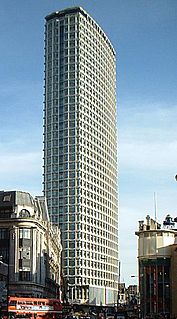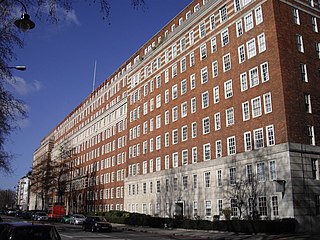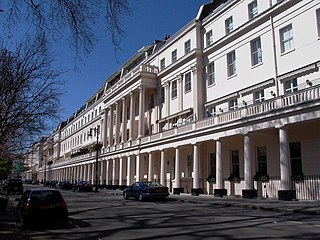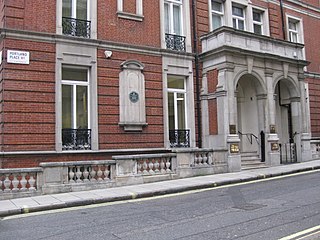
Centre Point is a building in Central London, comprising a 34-storey tower; a 9-storey block to the east including shops, offices, retail units and maisonettes; and a linking block between the two at first-floor level. It occupies 101–103 New Oxford Street and 5–24 St Giles High Street, WC1, with a frontage also to Charing Cross Road, close to St Giles Circus and almost directly above Tottenham Court Road tube station. The site was once occupied by a gallows, and the tower sits directly over the former route of St Giles High Street, which had to be re-routed for the construction.

The Barbican Estate, or Barbican, is a residential complex of around 2,000 flats, maisonettes, and houses in central London, England, within the City of London. It is in an area once devastated by World War II bombings and densely populated by financial institutions, 1.4 miles (2.2km) north east of Charing Cross. Originally built as rental housing for middle and upper-middle-class professionals, it remains to this day an upmarket residential estate. It contains, or is adjacent to, the Barbican Arts Centre, the Museum of London, the Guildhall School of Music and Drama, the Barbican public library, the City of London School for Girls and a YMCA, forming the Barbican Complex.

Sir Denys Louis Lasdun, CH, CBE, RA was an eminent English architect, the son of Nathan Lasdun (1879–1920) and Julie. Probably his best known work is the Royal National Theatre, on London's South Bank of the Thames, which is a Grade II* listed building and one of the most notable examples of Brutalist design in the United Kingdom.

Dolphin Square is a block of private flats with some ground floor business units near the River Thames in Pimlico, Westminster, London built between 1935 and 1937. Until the building of Highbury Square, it was the most developed garden square in London built as private housing. At one time, it was home to more than 70 MPs and at least 10 Lords.

Eaton Square is a rectangular, residential garden square in London's Belgravia district. It is the largest square in London. It is one of the three squares built by the landowning Grosvenor family when they developed the main part of Belgravia in the 19th century that are named after places in Cheshire — in this case Eaton Hall, the Grosvenor country house. It is larger but less grand than the central feature of the district, Belgrave Square, and both larger and grander than Chester Square. The first block was laid out by Thomas Cubitt from 1827. In 2016 it was named as the "Most Expensive Place to Buy Property in Britain", with a full terraced house costing on average £17 million — many of such town houses have been converted, within the same, protected structures, into upmarket apartments.

Coade stone or Lithodipyra or Lithodipra was stoneware that was often described as an artificial stone in the late 18th and early 19th centuries. It was used for moulding neoclassical statues, architectural decorations and garden ornaments of the highest quality that remain virtually weatherproof today.

The Golden Lane Estate is a 1950s council housing complex in the City of London. It was built on the northern edge of the City, on a site devastated by bombing during the Second World War. Since 1997, the estate has been protected as a group of listed buildings of special architectural interest.

Langleybury is a country house and estate in Abbots Langley Parish, Hertfordshire, England, about 3 miles (5 km) northwest of the centre of the town of Watford. The house stands on a low hill above the valley of the River Gade.

Norbury Park is a swathe of mixed wooded and agricultural land associated with its Georgian manor house near Leatherhead and Dorking, Surrey, which appears in the Domesday Book of 1086. It occupies mostly prominent land reaching into a bend in the Mole in the parish of Mickleham.

Benham Park is a mansion in the English ceremonial county of Berkshire and district of West Berkshire. It is 2 miles (3.2 km) west of Newbury within 500m of a junction of the A34 trunk road Newbury by-pass outside the town side, in the Marsh Benham locality of Speen, a village within and outside the Newbury by-pass. The house is a Grade II* listed building and park is Grade II.

Lichfield Court, in Richmond, London, consists of two Grade II listed purpose-built blocks of flats. Designed by Bertram Carter and built in fine Streamline Moderne style, it was completed in 1935.

Portland Place is a street in the Marylebone district of central London. Named after the Third Duke of Portland, the unusually wide street is home to BBC Broadcasting House, the Chinese and Polish embassies, the Royal Institute of British Architects and numerous residential mansion blocks.

St James's Place is a street in the St James's district of London near Green Park. It was first developed around 1694, the historian John Strype describing it in 1720 as a "good Street ... which receiveth a fresh Air out of the Park; the Houses are well-built, and inhabited by Gentry ..." Henry Benjamin Wheatley wrote in 1870 that it was "one of the oddest built streets in London."

The Kingston House estate and Ennismore Gardens in Knightsbridge is a green, dual-character area within the western limits of the City of Westminster in London. The first-named is immediately south of Hyde Park, London taking up the park's semi-panorama row of 8 to 13 Princes Gate (demolished) and otherwise, as to more of its wings, set around the east of Princes Gate Garden including a terrace of houses №s 1 to 7 Bolney Gate. The second-named is a garden square of 59 tall creamy-white terraced houses and the approach road to Prince of Wales Gate, Hyde Park as well as the identical-size public, square green of the church that is since 1956 the Russian Orthodox Cathedral of the Dormition of the Mother of God and All Saints facing which green are its anomalous outlier row for a London garden square, №s 61 to 66. The relatively small, broad-fronted house set against the Consulate-used pairing at №s 61 to 62 is № 60 and as with the other 65 numbers of Ennismore Gardens is a listed building.

The Blackfriar is a Grade II* listed public house on Queen Victoria Street in Blackfriars, London.

The Caledonian Estate is a Grade II listed, early Edwardian estate towards the northern end of the Caledonian Road in Islington, London. It is situated next to Pentonville Prison. The Estate was built on the site of the classical Caledonian Asylum from which the Road took its name.

New Burlington Street is a street in central London that is on land that was once part of the Burlington Estate. The current architecture of the street bears little resemblance to the original design of the street when first built in the early eighteenth century.

Cartwright Gardens is a crescent shaped park and street located in Bloomsbury, London.

South Audley Street is a major shopping street in Mayfair, London. It runs north to south from the southwest corner of Grosvenor Square to Curzon Street.

Westbourne Terrace is a street in the Paddington district of the City of Westminster in west London. The street runs between Westbourne Bridge in the north and the junction of Westbourne Crescent and Sussex Gardens in the south and was developed between 1839 and the late 1850s. It has been described as the "most spacious and dignified avenue" in Bayswater and "unrivalled in its class in London or even Great Britain". The street is not to be confused with Westbourne Terrace Road which runs north from Westbourne Bridge into Little Venice, and a large number of other Westbourne streets in the area.




















